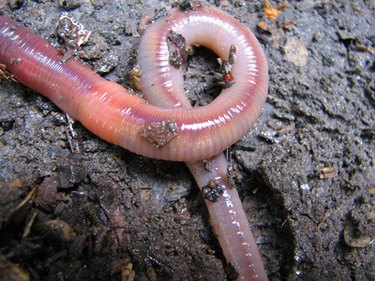
Vermicompost is a form of composting using worms. Worms are kept in bins and supplied with bedding, such as shredded newspaper, food in the form of non-meat kitchen scraps, and moisture. Worms help break down kitchen scraps and yard waste, speeding the composting process while providing essential microorganisms to the mix.
Odor
Video of the Day
Your vermicompost bin will smell like an old garbage can unless you maintain it properly. The odor is caused by an anearobic environment. When worms and compost are in an oxygen-low environment any scraps you place into the bin will not degrade. To maintain an aerobic, and good-smelling, environment you must evaluate three environmental components: moisture, air circulation and compost quantitiy.
Video of the Day
Monitor the amount of moisture in your bin. When you place your hands in the bin, the bedding materials should feel like a wrung out sponge. Reduce odor by keeping moisture levels low.
Construct your bin with ventiliation in mind. Bins normally have holes drilled into the sides and bottoms. The holes help excess moisture escape and they also aerate the bin. To improve circulation, pile bedding loosely.
If you find that moisture levels are adequate and air is circulating but you still smell an unappealing odor, feed your worms less. Slimy worms and foul bins indicate too much nitrogen, which is caused by excess kitchen scraps. Give your worms time to digest and consume.
Time
Some gardeners pick through the bins, removing only pinches of composted material and worm castings at a time. This time-consuming harvesting technique is definitely disadvantageous. Other gardeners have adopted better methods, such as placing racks in the bins. Wire racks keep worms separate from the compost. You lift the racks from the bin and sift the compost out, leaving the worms behind. You can also buy manufactured bins with racks already in place.
Other gardeners take their vermicompost bins into the sun and spread them out on a tarp. The worms will writhe away from light, going deeper into the compost. The gardeners harvest the worm-free top layer.
Incorrect Species
Not all worms are suitable for compost bins. Using the wrong worms will result in non-producing vermicompost bins. Red wrigglers are the best because they are active surface dwellers. They rapidly consume scraps and readily churn soil. Common worms found in your garden are deep dwellers. They do a good job at aerating soil but they will not produce good vermicompost. Not being able to dig worms out of your garden for your vermicompost pile is a bit of a disadvantage, especially if you were hoping to create your pile for free. You can find red wrigglers at bait stores, seed and pet stores or garden supply centers.
Escapes
Some apartment dwellers and urban homesteaders keep vermicompost bins in their homes. Remember to keep the lid closed. Light keeps worms burrowing deep into their bins. A dark apartment and a lidless bin are not a good combination. Although worms will not survive very long in dry, inhospitable environments, be aware that once out they make a mess, crawling up walls and tracking mud. That's quite the surprise when you turn on the light.